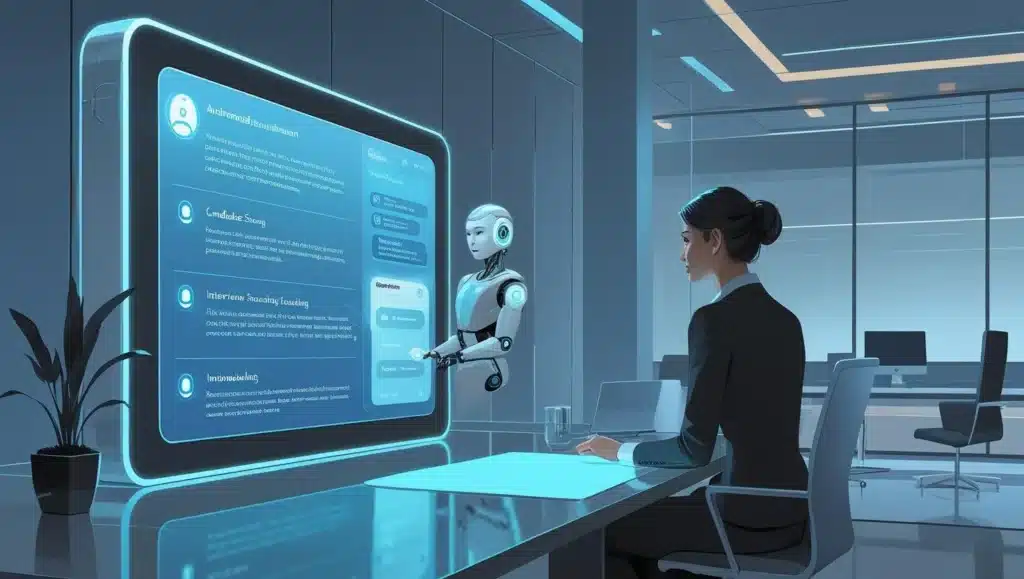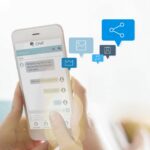A virtual assistant dedicated to human resources is a real time-saver, as it can greatly optimize HR processes.
But how do you actually optimize HR processes with a chatbot? In this article, we’ll give you an overview of how to create and integrate a chatbot into your HR processes. We’ll give you examples of tasks to automate in human resources, and then show you how to implement a chatbot in a company’s internal processes.
Defining a chatbot for human resources
An HR chatbot is an intelligent conversational agent designed to automate interactions between employees and human resources departments. It is based on artificial intelligence technologies such as Chat GPT. Thanks to its natural language processing, it is able to understand the requests it receives, and respond appropriately (leave balance, schedule, status of an application, etc.).
From a user’s query, a chatbot is able to trigger automated actions in the company’s internal systems! To take full advantage of this, the chatbot must be well integrated, continuously enriched, and secured to protect sensitive data.
It’s up to you to know exactly what you want the chatbot to do. Here are our best examples of HR tasks that can be automated by a dedicated chatbot !
How does an HR chatbot work?
The HR chatbot, whether used for recruitment, administrative management or day-to-day support, relies on a structured HR knowledge base and AI algorithms capable of interpreting user intentions. Unlike a simple internal search engine, it understands the context, reformulates if necessary, and adapts to profiles (employee, manager, recruiter…).
It will be able to operate on different channels: intranet, HR portal, instant messaging.
Connection to HR tools and internal systems
An effective HR chatbot is connected to the HRIS, internal HR databases and sometimes to a ticketing or helpdesk tool. It can automate HR processes such as filing a leave request, accessing a document, pre-qualifying a request, or notifying a manager.
Examples of HR chatbots for the recruitment process
An HR chatbot canautomate the entire recruitment process, from posting the job offer to onboarding the new employee. This virtual assistant will automate repetitive, time-consuming tasks that do not require a human agent. With an optimal chatbot, the recruitment process, and in particular the processing of applications, is greatly accelerated.
Here are the main examples of automation by this type of robot in recruitment:
- Intelligent candidate sourcing: automatic profile search on LinkedIn and Indeed according to precise criteria defined by recruiters;
- Multi-channel distribution of job offers: automated publication of ads on job boards, social networks and specialized sites with optimized SEO;
- Centralization and sorting of applications: aggregation of applications from several sources, CV analysis, extraction of key skills and experience via AI ;
- Pre-qualification of candidates: automatic dispatch of questionnaires or automated tests, scoring of responses and integration of results into the candidate file;
- Interview scheduling: slot proposals, synchronization with agendas, automated reminders and rescheduling;
- Automated communication : send acknowledgements of receipt, personalized responses and targeted reminders;
- Administrative onboarding: sending documents for signature, arrival checklist, passing on information to managers.
Concrete example of an HR chatbot connected to recruitment software
A candidate applies via a form hosted on a career site (connected to the ATS). The HR chatbot intervenes immediately to validate the application, ask preliminary questions (availability, expectations, mobility…), and propose an interview slot. All the information collected is automatically integrated into the ATS candidate file, without double entry.
Examples of HR chatbots for administration
The use of an HR chatbot to automate routine and administrative requests from employees has become standard in digital HR departments. Employees receive instant answers to a wide range of requests, 24 hours a day! Each response generated by the chabot is personalized. This takes the pressure off HR teams, who are often overwhelmed by repetitive requests!
Here are the main examples of tasks that a chatbot can automate for human resources agents:
- Requests for leave and absences: submit, track status, consult balance – everything is managed in real time!
- Access to administrative documents: pay slips, attestations, certificates, duplicates available on demand and securely;
- Answers to frequently asked questions: mutual insurance, employee benefits, teleworking, training, HR policy… with instant answers;
- Work time management: clocking in and out, consulting schedules, tracking overtime and accessing schedules via HRIS integration;
- Payroll assistance & legal obligations: instant answers on calculating remuneration, bonuses, tax ;
- Pre-qualification of HR requests: analysis of the request, referral to the right department, automatic creation of a ticket;
- Access to internal rules: regulations, charter, HR policy accessible via e-mail or intranet;
- Notifications and reminders: important deadlines, information campaigns, automatic and intelligent reminders;
- Support for managers: HR dashboards, key indicators, managerial reminders (interviews, integrations, etc.).
How do you set up an HR chatbot?

Creating and implementing an in-house HR chatbot requires a methodological approach and… the right chatbot. To structure an HR chatbot creation project and deploy the chatbot internally within the company successfully, we advise you to follow these steps.
1. Identify priority use cases
First and foremost, the real needs of employees and HR teams must be defined:
- What are your recurring requests? (vacation balances, pay slips, recruitment, onboarding…)
- What are the most time-consuming HR processes to automate?
This phase enables you to target the key functionalities to be integrated into the HR chatbot. See the examples of HR tasks to automate above!
2. Choose the right technology
Several solutions exist: rules-based chatbots, AI chatbots or LLM-based chatbots like ChatGPT for human resources. The choice depends on the level of complexity of interactions, the volume of queries and integration constraints.
The chatbot provides natural language processing (NLP), a seamless connection to HR systems (HRIS, helpdesk, intranet), and personalized responses based on user profiles.
3. Integrate the chatbot into the HR digital ecosystem
The company’s internal chatbot must integrate with existing tools, i.e. the HR intranet, the employee portal, instant messaging (Teams, Slack…) or even a mobile application! The chatbot needs to be easily accessible and intuitive if it is to be adopted as a tool within the company.
4. Test and refine the chatbot
Before a global roll-out, carry out a test phase on a restricted perimeter (e.g. HR department or pilot population). Analyze feedback, adjust dialogue paths and enrich the response database.
5. Supporting change and monitoring performance
Train key users (HR, managers, internal relays) to ensure smooth adoption of the chatbot. Communicate internally on the benefits of the HR chatbot: time savings, simplicity, availability.
You can regularly measure its impact via HR automation KPIs: usage rate, time saved, user satisfaction, resolution rate without human intervention.
Easily create and deploy an HR chatbot

Automating an HR process via a chatbot requires a good platform: fluid, easy to use and, above all, secure. In particular, the chatbot needs to be connected to a high-performance LLM system like ChatGPT. Many platforms offer no-code versions of chatbots, making it easier to create HR chatbots.
There are many online platforms for creating a chatbot, buthow do you choose the best one? The worry is that not all chatbots are created equal: some are limited to predefined responses, others don’t integrate AI, or don’t adapt to the specifics of HR processes. The risk is that the chatbot won’t be well integrated into your processes, and won’t be adopted by users. Which makes it… useless!
Added to this is the risk to company data.
Criteria for choosing the best HR chatbot platform
Our Botnation AI platform guarantees the implementation of a high-performance HR chatbot that meets your company’s internal needs and is easy for all employees to learn:
- Rapid integration of the chatbot with internal company tools and HR software: HRIS, ATS, intranet, Slack or Teams
- Intuitive no-code interface, compatible with leading AIs (ChatGPT, Claude, Mistral…)
- Data security and RGPD compliance by design
- Scalability and customization (business lines, use cases) and continuous improvement with intuitive control interface
- Real-time performance monitoring with analytical tracking
- Our chatbot solution experts are with you every step of the way!






